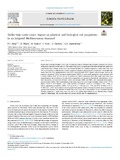Under-vine cover crops: Impact on physical and biological soil proprieties in an irrigated Mediterranean vineyard
Fecha
2023Autor
Versión
Acceso abierto / Sarbide irekia
Tipo
Artículo / Artikulua
Versión
Versión publicada / Argitaratu den bertsioa
Identificador del proyecto
MICIN//TED2021-130646B-I00
Impacto
|
|
10.1016/j.scienta.2022.111797
Resumen
We present a novel approach to harmonic disturbance removal in single-channel wind turbine
acceleration data by means of time-variant signal modeling. Harmonics are conceived as a set of
quasi-stationary sinusoids whose instantaneous amplitude and phase vary slowly and continuously
in a short-time analysis frame. These non-stationarities in the harmonics are modeled by
low-degree time polynom ...
[++]
We present a novel approach to harmonic disturbance removal in single-channel wind turbine
acceleration data by means of time-variant signal modeling. Harmonics are conceived as a set of
quasi-stationary sinusoids whose instantaneous amplitude and phase vary slowly and continuously
in a short-time analysis frame. These non-stationarities in the harmonics are modeled by
low-degree time polynomials whose coefficients capture the instantaneous dynamics of the corresponding
waveforms. The model is linear-in-parameters and is straightforwardly estimated by
the linear least-squares algorithm. Estimates from contiguous analysis frames are further combined
in the overlap-add fashion in order to yield overall harmonic disturbance waveform and its
removal from the data. The algorithm performance analysis, in terms of input parameter sensitivity
and comparison against three state-of-the-art methods, has been carried out with synthetic
signals. Further model validation has been accomplished through real-world signals and stabilization
diagrams, which are a standard tool for determining modal parameters in many timedomain
modal identification algorithms. The results show that the proposed method exhibits a
robust performance particularly when only the average rotational speed is known, as is often the
case for stand-alone sensors which typically carry out data pre-processing for structural health
monitoring. Moreover, for real-world analysis scenarios, we show that the proposed method
delivers consistent vibration mode parameter estimates, which can straightforwardly be used for
structural health monitoring. [--]
Materias
Trifolium fragiferum L.,
Soil organic carbon (SOC),
Particulate organic carbon (POC),
Hydraulic conductivity (Ks),
Soil structure,
Soil aggregation,
Soil microbial biomass
Editor
Elsevier
Publicado en
Scientia Horticulturae 311 (2023) 111797
Departamento
Universidad Pública de Navarra. Departamento de Agronomía, Biotecnología y Alimentación /
Nafarroako Unibertsitate Publikoa. Agronomia, Bioteknologia eta Elikadura Saila /
Universidad Pública de Navarra. Departamento de Ciencias /
Nafarroako Unibertsitate Publikoa. Zientziak Saila
Versión del editor
Entidades Financiadoras
This work has been partially funded by Grant TED2021-130646B-I00
(UNDERVINE) by MCIN/AEI/10.13039/501100011033 and by the
European Union NextGeneration EU/PRTR and by Grant PC044-045
(CUALVID) by Gobierno de Navarra (0011-1383-2022-000000).
F. J. Abad is a beneficiary of the postgraduate scholarship funded by
INIA (FPI-INIA-2016).






